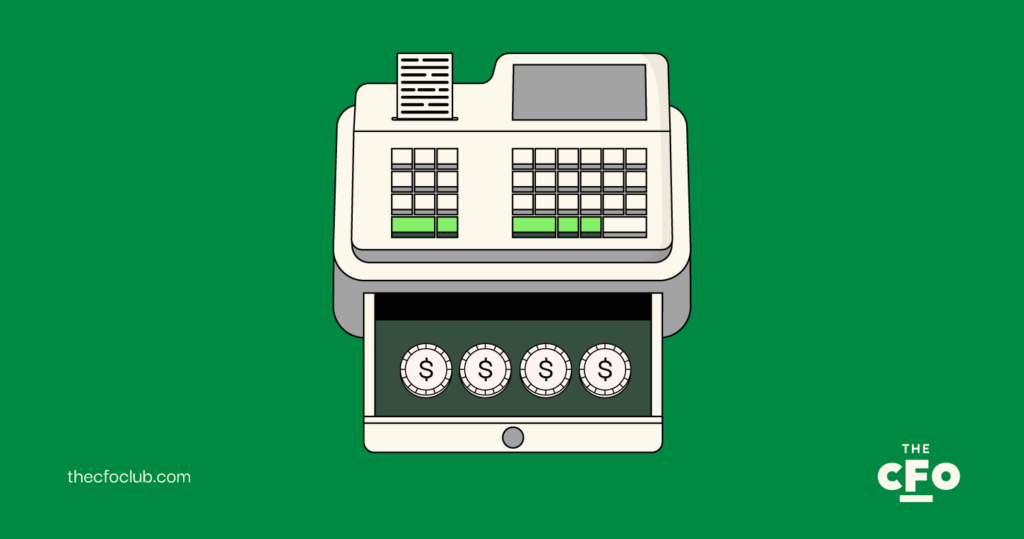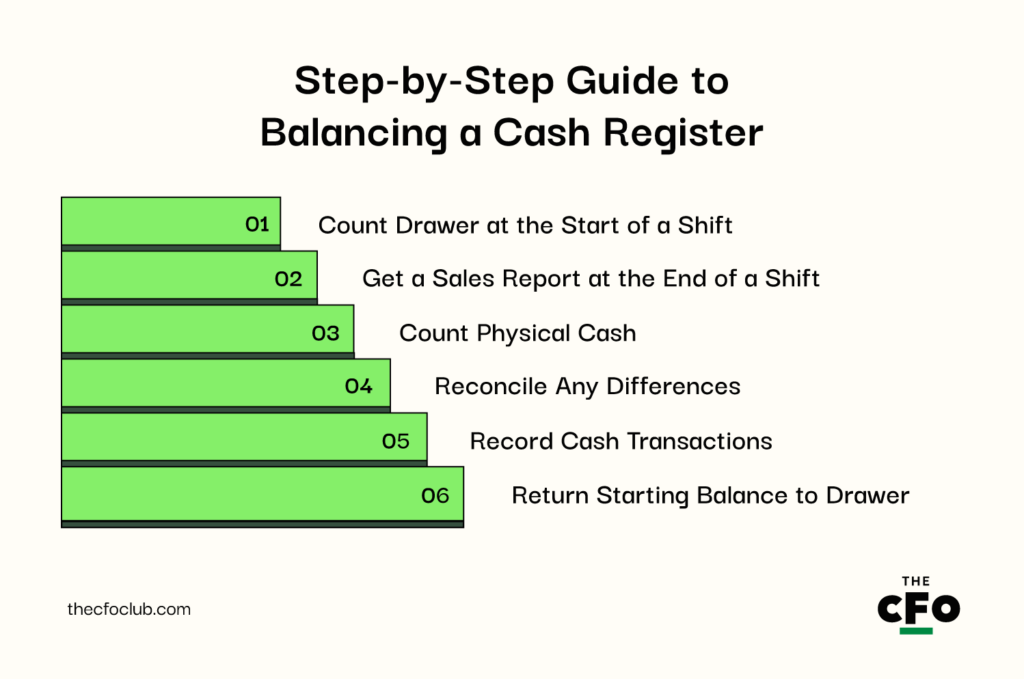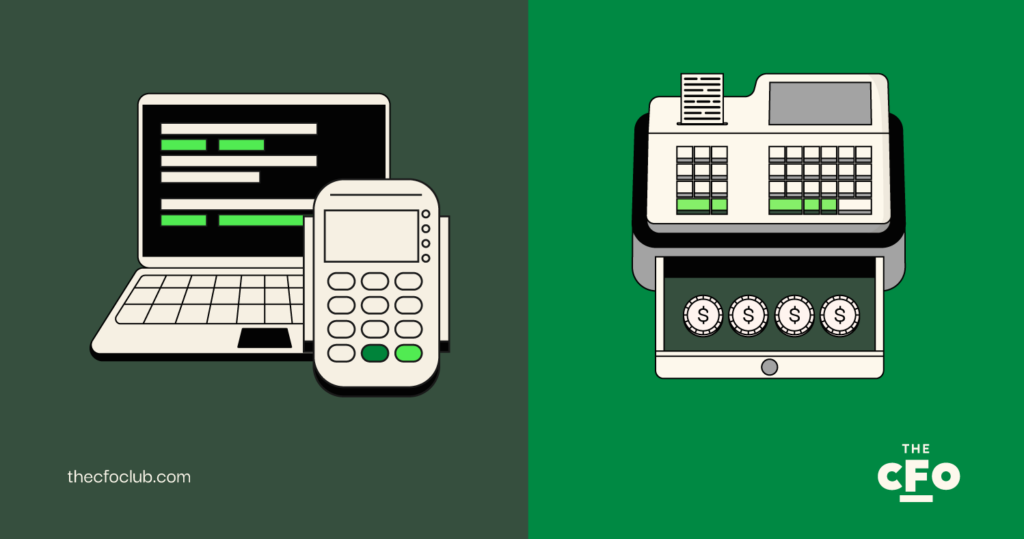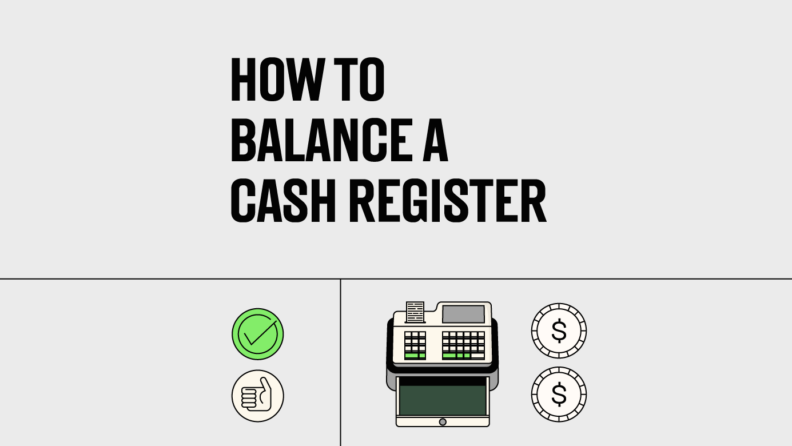Tiny Errors, Big Impact!: Small mistakes in cash management can accumulate, affecting financial records and causing stress. Accurate balancing ensures smooth operations and accountability.
Balancing Made Simple: Make sure to count the drawer at the start of each shift, include credit payments, and reconcile differences to ensure your cash register is consistently balanced.
Avoiding Inaccurate Reporting: Keep detailed records of all cash and credit transactions, make frequent cash drops, and look into any discrepancies to avoid inaccurate reporting.
Balancing a cash register might seem like a small task, but when it’s not done right, things can get messy fast—mismatched records, confusion, and unnecessary stress.
As a former accountant with several years experience, I know how crucial good cash-handling habits are for smooth operations and team trust. That’s why I’ve put together this simple, step-by-step guide to help you stay on top of things. Whether you’re new to it or just need a refresher, this walkthrough will make balancing your register easier, more accurate, and a lot less stressful.
What is a Cash Register?
A cash register, also called a cash drawer, is a machine used in retail and other cash-based businesses to record sales. It includes a drawer to store cash and coins, a keyboard or touchscreen interface, and a receipt printer.

These types of systems are different from point of sale (POS) systems. Point of sale systems, for instance, use hardware and software to complete transactions, whereas cash registers are generally mechanical. Most modern businesses use a POS system or a combination of both, making it easier to manage transactions and balance finances.
Importance of Balancing Your Cash Register
Whether you use a POS system with your cash register or not, it’s important to know how to balance your cash register. This is vital for two reasons:
- Clarity of Cash Flow: Balancing helps you calculate the amount of cash you hold. This is important because, as cash flow management 101 teaches, you always want enough cash on hand, but never too much.
- Accountability: It helps establish accountability, which makes it easy to find the person responsible for errors or theft. If there’s ever a shortage in cash, you’ll find it faster if you balance your cash register regularly.
Starting Tips for Balancing Your Cash Register
Before you put your regular balancing process in motion, there are two constants you should establish.
Determine the Best Starting Amount
The first constant is the amount of money you want in your drawer at the beginning of the day. Keeping excessive cash in your drawers can have opportunity costs, especially if you have hundreds of cash registers across locations.
There are also other risks to consider. For example, if drawers are jam-packed with cash, bills could slip out when staff members are handling cash or get stuck in crevices at the back of the register.
Once you have a desired amount in mind, make sure that at the start of the day, it's divided into denominations in a way that covers the need for change money throughout the day.
Assign One Employee Per Register
The second constant should be the employee. When beginning to balance your cash registers, make sure to assign just one employee per register for a given shift. If employees switch between registers, there’s more room for errors.
This strategy also establishes accountability. If any cash handling discrepancies occur, they can be easily traced to a single employee, streamlining operations and enhancing overall visibility.
Step-by-Step Guide to Balancing a Cash Register
Now that you’ve established the constants, let’s look at the process to follow to balance a cash register.

1. Count Drawer at the Start of a Shift
Before kicking things off at the start of the shift, the employee handling the cash drawer should do a physical count of the cash in the drawer. The balance in the cash register should be the same each day.
2. Get a Sales Report at the End of a Shift
At the end of each shift, the employee must pull the POS report for that specific shift. The report typically includes details about all transactions executed through the POS system during the shift. The details in the report may vary among POS systems, but generally include the employee who was involved, the customer’s name, items sold, and the amount paid.
3. Count Physical Cash
Once you have the POS report, count the cash in the drawer. This includes physical cash, checks, credit card receipts, and coupons. If you receive lots of cash every day, it’s worth investing in a counting machine—it will help you count faster and eliminate chances of errors during this process.
Then, subtract the starting balance from the total cash received during the shift.
For example, suppose you maintain $500 in cash in the drawer at the beginning of each shift. During the last shift, the employee received $1,000 in cash, and $1,500 worth of items were paid for using digital payment methods such as credit and debit cards.
This means the drawer should have $1,500 at the end of the shift, while the POS will show total sales of $2,500 ($1,000 + $1,500).
4. Reconcile Any Differences
Differences are common, especially in small businesses. You might have a shortage or extra cash (called overage) with you in the following cases:
- Incorrect Counting: Sticky notes or hasty counting can result in incorrect counting. Recounting cash should be your first line of defense.
- Lost Cash: The employee either lost a bill or two, or gave a customer more than the change they were supposed to. Check your drawer again to look for lost cash.
- Theft: The employee or someone else could’ve stolen the cash.
- Shortchange: Shortchanging customers is the only cause for overages.
5. Record Cash Transactions
If you were able to resolve all discrepancies, record the cash transactions in your books. Make sure you record cash received and not the total cash balance in the drawer because that includes the beginning balance ($500 in our example above).
6. Return Starting Balance to Drawer
At this point, you can empty the cash register drawer and leave the starting balance in there for the next shift. Make sure you have adequate internal controls and a defined process to handle cash beyond this point to prevent employee theft and loss of cash.
Best Practices for Cash Handling
Following best practices protects you against theft, helps maintain accountability, and prevents theft. Let’s talk about three best practices to keep in mind when handling cash in cash drawers.
Establish an Appropriate Beginning Balance
Establishing a set cash float brings consistency to the process. At the end of the day or shift, the employee responsible can easily determine the amount that should stay in the drawer.
You might even consider prescribing denominations that make up the cash float to ensure there’s enough to provide change to customers during the next shift.
Tracing shortages or overages is easier when you have a set starting amount. It helps identify if the issue occurred during the shift or if the float was incorrect to begin with.
Make Cash Drops
Overcrowded drawers make handling cash more difficult—employees might drop a bill or two when returning change to customers or some bills might get stuck at the back of the drawer.
Whenever the drawer starts to fill up to the brim, the employee handling the drawer should manually remove the cash from the drawer and drop it to a secure location. Make sure the employee signs off on the cash drop for accountability.
Secure Counting Location
The actual counting should take place in a secure location. This is a critical internal control that protects your cash against risks like misappropriation. The location should be secured with cameras and only authorized personnel should be allowed to enter.
When the employee counts cash, make sure another employee is present. This dual control helps verify the accuracy of the count and reduces the risk of theft. If you handle large amounts of cash daily, consider setting up escorted transfers at regular intervals for maximum security.
Troubleshooting Common Cash Drawer Discrepancies
If a recount doesn’t fix a discrepancy you noticed when reconciling cash with the POS report, there are a few alternatives you should try.
Verify the Day’s Transactions
Misrecorded transactions, unlogged sales, and incorrect refunds are common causes of discrepancies. Check all sales receipts, invoices, and POS records to verify that all transactions were recorded correctly and that any voids, discounts, or refunds were handled appropriately.
Review Cash Handling Processes
The cash-handling process starts with leaving the correct amount of float in the cash register at the end of the shift. Make sure that all employees, including new hires, are aware of the amount to leave in the cash drawer at the end of the shift. Verify if your employees are trained to use the POS correctly and understand common pitfalls the cash handling process is prone to.
Look into Employee Errors
Employee errors are the most common cause of discrepancies, and it’s okay. A reconciliation can confirm if this caused the discrepancies. If employee errors seem to be the most common cause of discrepancies, look for ways to minimize them. For example, consider investing in an automated POS system or software and offer additional training on handling cash more effectively.
Tackle Bigger Issues
Recurring discrepancies often hint at a more deeply rooted issue. Ineffective or insufficient training, unclear processes, or lax policies can translate to frequent discrepancies that take time to resolve.
Utilizing Technology for Cash Management
Technology can greatly simplify the way you manage cash registers and make the process more efficient, accurate, and secure. Most of these features are available on a POS system. Here’s how using cash management technology or a POS system can help:

- Automate Processes: Modern POS systems help you integrate cash registers and other hardware with software to automate sales processing, inventory tracking, discount management, and generating reports.
- Permission Management: A POS system can help set up access controls. Only employees with permission can control the cash register to perform tasks like opening it, refunding money, and removing cash.
- Real-Time Cash Monitoring: Some POS systems offer a real-time cash monitoring feature. The feature allows you to monitor cash levels in the drawer and alerts the manager whenever the cash level is too high or too low.
- Integration With Accounting Software: Top accounting software solutions offer integrations for POS systems that help automatically transfer sales data, including cash transactions, for error-free bookkeeping.
- AI-Powered Fraud Detection: AI-powered tools are great at detecting unusual cash register activities. AI can pick up on frequent voids, refunds, or discounts that are outside normal patterns. It’s also a great addition to your security toolkit and makes preventing and detecting fraud a lot easier.
Choosing one of the top POS systems out there to get access to an extensive feature set. Your best options include:
Training Staff in Effective Cash Register Management
Training staff to effectively execute the cash register management process is key to minimizing human errors. Here are two things you can do to train your staff:
Develop Training Programs
Develop training programs that help the staff understand the process as well as the importance of effective cash management. It’s often thought that tying the work your staff does to real implications for the company can help improve buy-in. Additionally, periodically hold training sessions and make training a part of the onboarding process for new hires.
Practice and Feedback
Some employees might need practice before they can perfect the process. Allow time for practice and provide constructive feedback to help them close any gaps. If they’re still struggling, that’s where the training program can help them refresh their information about how to manage the cash register effectively.
What’s Next?
Looking for insights that can help grow your financial career? Subscribe to our free newsletter.



